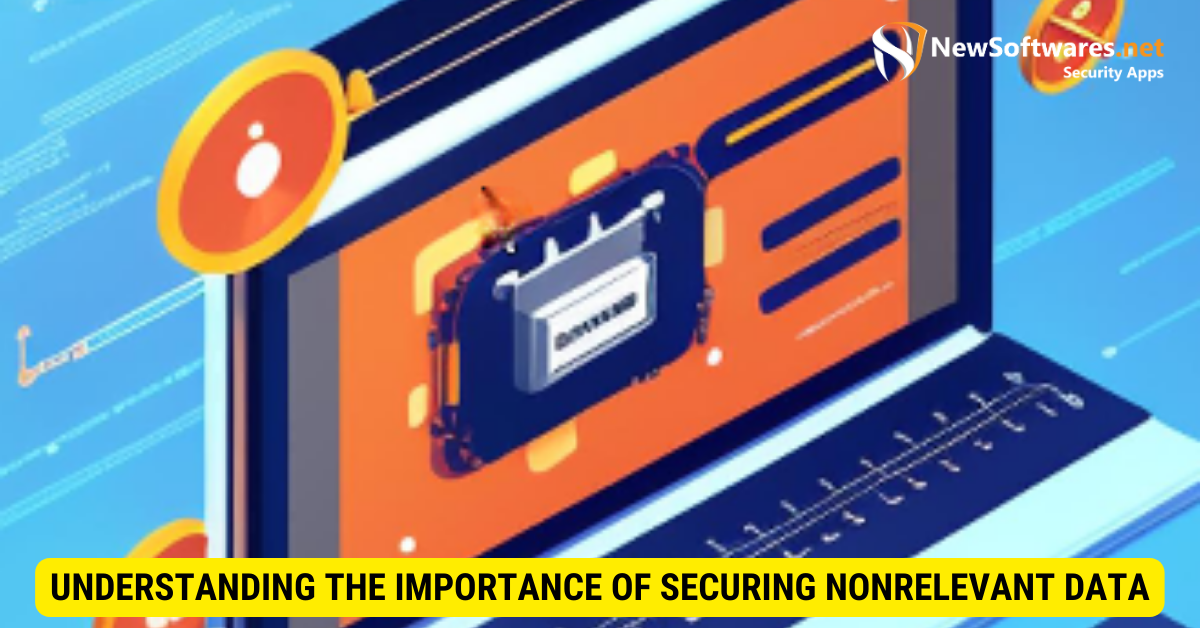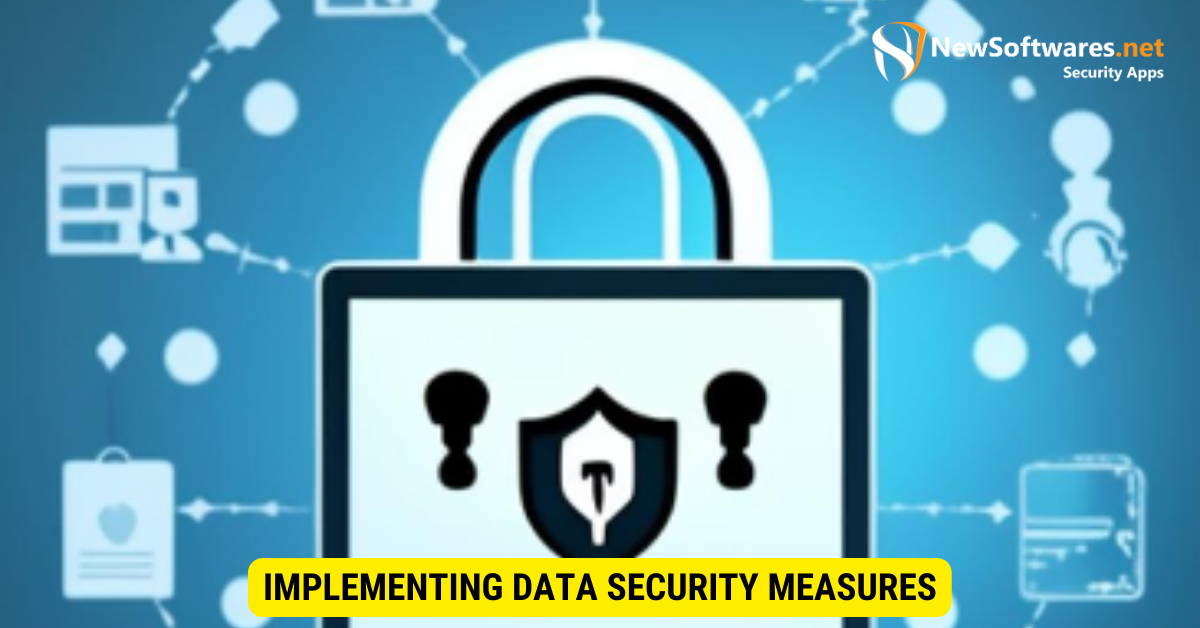Securing nonrelevant data involves implementing measures to protect data that may not be directly related to core operations but could still be valuable to unauthorized entities. To secure nonrelevant data:
Identify and Classify: First, determine what constitutes “nonrelevant” data within your system. Once identified, classify this data based on its sensitivity and potential risk.
Encryption: Use strong encryption techniques to protect data at rest and during transmission.
Access Control: Limit access to nonrelevant data. Only authorized personnel who need to work with this data and apply strict authentication and authorization protocols.
Regular Audits: Conduct routine security audits to identify potential vulnerabilities and ensure data remains secure.
Data Minimization: If certain nonrelevant data is unnecessary, consider securely deleting or anonymizing it.
Backup and Recovery: Ensure you have backup solutions and a clear recovery process for potential data breaches or loss.
In today’s data-driven world, the importance of data security cannot be overstated. Organizations must protect their sensitive and critical information and address the security of nonrelevant data. While nonrelevant data may not hold immediate value, it still poses a threat if left vulnerable to cyber threats. Together, we will discover the significance of securing nonrelevant data, the steps involved, the challenges faced, the best practices to adopt, and the future of data security.
Understanding the Importance of Securing Nonrelevant Data

Data security has become a critical concern for organizations worldwide in today’s digital age. While much emphasis is placed on protecting sensitive and valuable information, it is equally important to secure nonrelevant data. But what exactly is nonrelevant data, and why does it require protection?
Defining Nonrelevant Data
Before delving into the intricacies of securing nonrelevant data, let us define what it entails. Nonrelevant data refers to information that is not directly related to an organization’s core operations or sensitive assets. Examples include outdated customer records, expired contracts, or unused project documentation.
Although this data may seem insignificant, it can still risk an organization’s overall security posture if left unprotected. Therefore, it is crucial to understand the potential threats associated with nonrelevant data and take appropriate measures to safeguard it.
Why Nonrelevant Data Needs Protection

While nonrelevant data might not contain obvious value, malicious actors can still exploit it. Cybercriminals are constantly evolving their tactics and plans, and they can leverage seemingly insignificant data to gain insights into an organization’s operations, identify vulnerabilities, or launch targeted attacks.
For instance, outdated customer records may contain personal information that can be used for individuality theft or social engineering attacks when combined with other data sources. Expired contracts or unused project documentation may reveal sensitive business strategies or intellectual property, which can be destructive if it falls into the wrong hands.
Furthermore, data privacy regulations demand organizations to safeguard all types of data, regardless of their relevance. Non-compliance with these rules can result in severe legal and financial penalties, including hefty fines and reputational damage.
Therefore, organizations must adopt a comprehensive approach to data security encompassing all data types, including nonrelevant information. This includes implementing robust security measures, such as access controls, encryption, and regular data audits, to ensure nonrelevant data’s confidentiality, integrity, and availability.
In conclusion, while nonrelevant data may not hold immediate value, protecting it from potential threats is still essential. By doing so, organizations can mitigate risks, comply with data privacy regulations, and maintain a strong security posture.
Steps to Secure Nonrelevant Data
Securing nonrelevant data is a critical aspect of data management and protection. Organizations can ensure that a systematic approach adequately safeguards this data. The following steps outline the process:
Identifying Nonrelevant Data
The first step in securing nonrelevant data is to identify and categorize it. This process involves a thorough assessment to determine which data falls into this category. Collaborating with different departments and stakeholders is essential to ensure comprehensive coverage.
During the identification process, organizations should consider various factors, such as the data’s relevance to the organization’s operations, legal requirements, and potential risks associated with its exposure. By carefully analyzing these aspects, organizations can effectively differentiate between relevant and nonrelevant data.
Implementing Data Security Measures

Once nonrelevant data is identified, it is crucial to implement appropriate security measures. These measures protect the data from unauthorized access, disclosure, or alteration. Organizations can employ various techniques to enhance data security:
- Encryption: Encrypting nonrelevant data can provide an additional layer of protection. By converting the data into an unreadable format, even if unauthorized individuals gain access to it, they cannot decipher its contents.
- Access Controls: Implementing access controls ensures that only authorized individuals can access nonrelevant data. This can involve setting up user authentication mechanisms, such as passwords or biometric verification, and defining user roles and permissions.
- Data Mapping Techniques: Data mapping involves identifying the flow of nonrelevant data within an organization’s systems and networks. Organizations can implement appropriate security controls at each stage to prevent unauthorized access or data breaches by understanding how this data is stored, transmitted, and processed.
By applying these measures, organizations can limit unauthorized access and strengthen the overall security posture, reducing the risk of nonrelevant data falling into the wrong hands.
Regular Monitoring and Updating of Security Protocols
Data security is an ongoing process that requires continuous monitoring and updating of security protocols. Regular audits must be conducted to identify any vulnerabilities or changes in the data landscape. Organizations should establish a robust monitoring system that includes:
- Real-time Monitoring: Implementing tools and technologies to monitor data access, network traffic, and system activities in real time. This enables organizations to detect any suspicious or unauthorized activities promptly.
- Security Incident Response: Establishing a well-defined incident response plan to address security breaches or incidents related to nonrelevant data. This plan should outline the steps to be taken, the individuals responsible, and the communication channels to be used in case of a security incident.
- Regular Training and Awareness: Conduct regular training sessions and awareness programs for staff to educate them about best practices for data security. This ensures that everyone in the association understands their role and responsibilities in maintaining data security.
Organizations can effectively mitigate potential risks associated with nonrelevant data by staying vigilant and adaptive. Regularly monitoring and updating security protocols help ensure that the implemented measures remain effective and aligned with the evolving threat landscape.
Challenges in Securing Nonrelevant Data
Securing nonrelevant data presents unique technological challenges. As data volumes grow, establishments need robust and scalable solutions to protect this data effectively. With the proliferation of digital platforms and interconnected systems, the risk of unauthorized access and data breaches has become a pressing concern. Organizations must employ advanced encryption techniques, access controls, and intrusion detection systems to safeguard nonrelevant data from potential threats.
Implementing security measures without disrupting day-to-day operations requires careful planning and integration. Administrations must strike a delicate balance between ensuring data security and maintaining seamless workflows. This involves conducting thorough risk assessments, identifying vulnerabilities, and implementing appropriate security protocols. Furthermore, organizations may need to invest in training programs to educate workers about data security best practices and increase awareness about the importance of protecting nonrelevant data.
Legal and Compliance Issues
Data secrecy regulations such as the General Data Protection Regulation (GDPR) and the California Consumer Privacy Act (CCPA) demand organizations to protect all types of data, including nonrelevant data. These regulations safeguard individuals’ privacy rights and hold organizations accountable for handling personal information. Failure to obey these rules can result in severe penalties and reputational damage.
Navigating the legal landscape and ensuring compliance poses significant challenges while securing nonrelevant data. Organizations must stay up-to-date with evolving regulations and adapt their data security practices accordingly. This involves conducting regular audits, implementing data protection impact assessments, and establishing robust data retention and disposal policies. Organizations may also need to appoint data protection officers or seek legal counsel to ensure compliance with the complex web of privacy laws.
Furthermore, organizations operating in multiple jurisdictions face the additional challenge of complying with varying data protection laws. They must navigate the intricacies of international data transfers and ensure that nonrelevant data is adequately protected, regardless of physical location. This requires a deep understanding of cross-border data transmission mechanisms, such as standard contractual clauses or binding corporate rules, and the ability to implement them effectively.
Best Practices in Nonrelevant Data Security
Adopting a Data-Centric Security Approach
Organizations should adopt a data-centric security approach that prioritizes protecting all data, regardless of its relevance. Organizations can establish a robust security framework by focusing on data encryption, secure data disposal, and implementing data loss prevention measures.
Ensuring Regular Data Audits
Regular audits and assessments are essential to identify any gaps or vulnerabilities in the security infrastructure. Organizations can proactively address potential security risks by conducting periodic data audits and ensuring compliance with data protection regulations.
Training and Awareness Programs
Workers play a crucial role in data security. Conducting training programs and raising awareness about the importance of securing nonrelevant data can significantly reduce the risk of data breaches. Organizations can foster a culture of security by educating employees on best practices and the potential consequences of neglecting data security.
The Future of Nonrelevant Data Security
Emerging Trends in Data Security
Data security is continuously growing, and several emerging trends are shaping the future of nonrelevant data security. These include advancements in encryption algorithms, adopting zero-trust frameworks, and integrating Artificial Intelligence (AI) to detect and reply to security threats.
The Role of AI and Machine Learning in Data Security
AI and machine learning skills have the potential to convert data security. Organizations can detect anomalies, predict potential breaches, and automate threat response by leveraging AI-driven algorithms. Integrating AI and machine learning holds immense promise in safeguarding nonrelevant data in real time.
Key Takeaways
- Always encrypt nonrelevant data.
- Regularly audit and review stored data.
- Implement access controls, ensuring only authorized individuals can access the data.
- Consider pseudonymization or anonymization techniques.
- Regularly delete nonrelevant data that is no longer needed.
FAQs
Q: Why should nonrelevant data be secured?
A: Even nonrelevant data can be used maliciously if combined with other data sets or if its context changes.
Q: How often should I review nonrelevant data?
A: Regular reviews, perhaps annually, are advisable to determine if data should still be stored.
Q: What encryption methods are recommended for nonrelevant data?
A: AES encryption is a widely accepted standard.
Q: Can I store nonrelevant data in the cloud?
A: Yes, but ensure the cloud provider adheres to robust security standards and encrypts the stored data.
Q: How long should nonrelevant data be retained?
A: This depends on the organization’s data retention policy. Ensure it is reviewed periodically.
Conclusion
In conclusion, securing nonrelevant data is integral to data security strategy. Organizations must understand the importance of protecting all data types, even if they may not seem immediately valuable. Organizations can strengthen their security posture by following the steps to secure nonrelevant data, addressing the associated challenges, and adopting best practices. Embracing emerging trends and leveraging AI and machine learning technologies will pave the way for a more secure future of data management.
